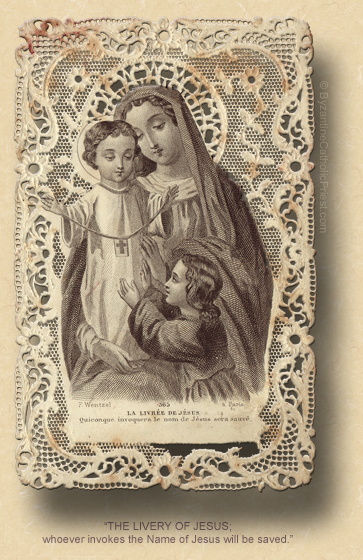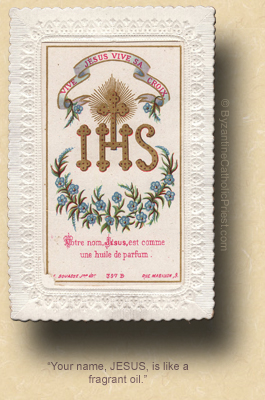At the Name of Jesus, Every Knee Should Bend.
The Second Day after the Octave of the Nativity; or, the Memorial of the Most Holy Name of Jesus.*
Lessons from the feria, according to the ordinary form of the Roman Rite:
• I John 2: 29—3: 6.
• Psalm 98: 1, 3-6.
• John 1: 29-34.
The Second Day after the Circumcision.**
Lessons from the feria, according to the extraordinary form of the Roman Rite:***
• Titus 2: 11-15.
• Psalm 97: 3, 4, 2.
• Luke 2: 21.
[In the Byzantine-Ruthenian Rite, the Friday & Saturday after the Circumcision are pre-festive Days of the Theophany, with the Royal Hours celebrated on Friday; the Divine Liturgy is not prescribed.]
FatherVenditti.com
|
 9:23 AM 1/3/2015 — These few ferial days we have between Christmas and Epiphany [in the ordinary form] present to us certain conversations John the Baptist has with various people: representatives of the Sanhedrin who are trying to figure out what he's all about, his own disciples who seem to be concerned that there's this Jesus fellow whom they think is stealing some of John's thunder, and finally our Blessed Lord Himself. I'm sure it's unrealistic for me to think that you could remember a homily I preached for you back in June, shortly after I first arrived here; but, it was on the Solemnity of the Nativity of John the Baptist that I referenced a remark made by St. Augustine, in the 4th century, in which he points out that the date for celebrating the Baptist's birth was chosen because of its proximity to the Summer Solstice when the days begin to grow shorter, as opposed to the Nativity of our Lord, which corresponds to the Winter Solstice when the days start to grow longer, which he says is consistent with the remark made by John the Baptist in John's Gospel whereupon being told that Jesus has begun to baptize as he was, he says, “He must increase, and I must decrease” (John 3:30). Which, when you think about it, is the quintessential statement of the interior life for the Christian: our goal should be to reproduce in ourselves the life of Christ so perfectly that we ourselves begin to disappear and Christ begins to show through us in perfect purity. 9:23 AM 1/3/2015 — These few ferial days we have between Christmas and Epiphany [in the ordinary form] present to us certain conversations John the Baptist has with various people: representatives of the Sanhedrin who are trying to figure out what he's all about, his own disciples who seem to be concerned that there's this Jesus fellow whom they think is stealing some of John's thunder, and finally our Blessed Lord Himself. I'm sure it's unrealistic for me to think that you could remember a homily I preached for you back in June, shortly after I first arrived here; but, it was on the Solemnity of the Nativity of John the Baptist that I referenced a remark made by St. Augustine, in the 4th century, in which he points out that the date for celebrating the Baptist's birth was chosen because of its proximity to the Summer Solstice when the days begin to grow shorter, as opposed to the Nativity of our Lord, which corresponds to the Winter Solstice when the days start to grow longer, which he says is consistent with the remark made by John the Baptist in John's Gospel whereupon being told that Jesus has begun to baptize as he was, he says, “He must increase, and I must decrease” (John 3:30). Which, when you think about it, is the quintessential statement of the interior life for the Christian: our goal should be to reproduce in ourselves the life of Christ so perfectly that we ourselves begin to disappear and Christ begins to show through us in perfect purity.
That, of course, is an ideal rarely obtained except by the saints. Some of you, I'm sure, are familiar with the life of the Little Flower; her “little way,” as she called it, was really nothing more than this spiritual principle so simply and perfectly expressed by the Baptist in John's Gospel: “He must increase, and I must decrease.” But, as I said, it's a rather lofty spiritual goal; and, with all the pragmatic concerns we have to deal with every day—in our jobs, with our families, in the daily spiritual combat that is Christian living—it's very difficult to even think of achieving this lofty goal; unless, of course, we're going to follow the lead of the Desert Fathers and retreat into a hermitage somewhere to live out our lives, but that is not the choice that any of us have made.
But there is a way that we can actually do this to a degree, and it was very simply and beautifully put by a saint canonized not too long ago, and that's St. Josemaría Escrivá, and I've quoted this line to you before. He said that, for those of us in the world, whether we be lay people or priests, it is enough to strive for the goal that, when others see us act or hear us speak, they would be able to say, “That person has read the life of Jesus Christ.”
 We are particularly blessed on two fronts today, for not only is it the first Saturday of the month, on which we honor the requests of our Lady of Fatima with a Eucharistic Holy Hour following Holy Mass, but it's also the Memorial of the Most Holy Name of Jesus, a devotion promoted by the Franciscan missionary, Saint Bernadine of Siena, in the 15th century, and which he popularized through the use of an ancient monogram from the 3rd century, which appears to us to read “IHS”. You see it often on the covers of books and missals, and you often see it embroidered on liturgical vestments. In fact, you can see it on the back of the chasuble I'm wearing right now, as well as on the cover of my copy of the Roman Breviary. Everyone recognizes it, but a lot of people don't know what it means; they either think it stands for something in Latin, or else they come up with their own bizarre theories: I met someone once who actually tried to tell me that the reason it's displayed on a priest's vestments, especially those which are very old fashioned like these, is because it stands for “In His Service.” Well, it doesn't. It's really very simple: it's the first three letters of the name “Jesus” in Greek. In fact, this particular style of chasuble, which used to be very popular in the old days but is now only worn by dusty old relics like me, dates from the 15th century and was made popular by Saint Bernadine of Siena in honor of the Most Holy Name of Jesus. We are particularly blessed on two fronts today, for not only is it the first Saturday of the month, on which we honor the requests of our Lady of Fatima with a Eucharistic Holy Hour following Holy Mass, but it's also the Memorial of the Most Holy Name of Jesus, a devotion promoted by the Franciscan missionary, Saint Bernadine of Siena, in the 15th century, and which he popularized through the use of an ancient monogram from the 3rd century, which appears to us to read “IHS”. You see it often on the covers of books and missals, and you often see it embroidered on liturgical vestments. In fact, you can see it on the back of the chasuble I'm wearing right now, as well as on the cover of my copy of the Roman Breviary. Everyone recognizes it, but a lot of people don't know what it means; they either think it stands for something in Latin, or else they come up with their own bizarre theories: I met someone once who actually tried to tell me that the reason it's displayed on a priest's vestments, especially those which are very old fashioned like these, is because it stands for “In His Service.” Well, it doesn't. It's really very simple: it's the first three letters of the name “Jesus” in Greek. In fact, this particular style of chasuble, which used to be very popular in the old days but is now only worn by dusty old relics like me, dates from the 15th century and was made popular by Saint Bernadine of Siena in honor of the Most Holy Name of Jesus.
Several times each day we pray the Hail Mary. It's official title, as you know, is the Angelic Salutation, and it comes from chapter one of Luke's Gospel, in which the angel Gabriel salutes the Blessed Virgin with the words: “Hail, thou who art full of grace; the Lord is with thee; blessed art thou among women” (Luke 1: 28 Knox). When it started to become popular as a prayer in the 11th century, the name of the Mother of God was inserted into it, and it started the take the form we know today: Ave Maria, gratia plena, Dominus tecum. Benedicta tu in mulieribus, et benedictus fructus ventris tui. "Hail Mary, full of grace, the Lord is with thee. Blessed art thou among women, and blessed is the fruit of thy womb." But it was Bernadine of Siena, as part of his preaching about the Most Holy Name, who first added the Holy Name of Jesus to the end of that sentence.
I'm not sure if I've given you worthy material for reflection for your Holy Hour today, or if I've just distracted you from your prayer. In any case, let's include, in the intentions that each of us bring to this Holy Sacrifice, a prayer that the Most Holy Name of Jesus, so often used today in profane and godless ways, will be given the respect that the name of God deserves, so that, as today's introit says, “At the name of Jesus, every knee should bend, of those in heaven and on earth and under the earth, and every tongue confess that Jesus Christ is Lord, to the glory of God the Father.”

* In the extraordinary form of the Roman Rite, the Second Class Feast of the Most Holy Name of Jesus is celebrated on the Sunday occuring between the 2nd and 5th of January or, if there is no Sunday, on January 2nd, with the Epiphany always observed on January 6th. In the ordinary form in the United States, the Epiphany is transfered to the aforementioned Sunday, with the Holy Name of Jesus observed as an optional memorial on January 3rd.
** It is a pecurliarity of the Missal of St. John XXIII (1962) that January 1st is designated as "The Octave Day of the Nativity" and not called the Circumcision, while the ferial days following are listed as "Ferias after the Circumcision."
*** In point of fact, the Scripture lessons for January 2nd through the 5th in the extraordinary form repeat themselves on each day: the Epistle is from the first Mass of Christmas, and the gradual psalm and Gospel are both from the Octave Day of the Nativity (the Circumcision).
|

